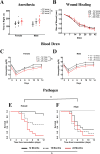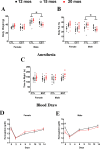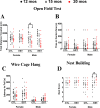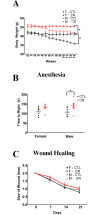Negative effects of lifespan extending intervention on resilience in mice
- PMID: 39570905
- PMCID: PMC11581327
- DOI: 10.1371/journal.pone.0312440
Negative effects of lifespan extending intervention on resilience in mice
Abstract
One key goal of basic aging research is the development of reliable assays of both current and future health. These assays could dramatically accelerate progress toward developing health-extending interventions by obviating the need for full lifespan studies, especially if they were informative relatively early in life. One potential approach is the assessment of physiological resilience, defined as the ability to recover from an adverse event. Here, using CB6F1 mice, we evaluated four potential resilience assays, each quantifying recovery from a physiological challenge with clear relevance to humans. The challenges were: (1) anesthesia recovery, (2) restoration of hemoglobin levels after a blood draw, (3) speed of wound healing, and (4) survival after pathogen exposure. We evaluated how each changed with age and with interventions known to extend health in males only (17α-estradiol) or both sexes (calorie restriction). We found that three of the four (recovery from anesthesia, blood draw, and pathogen exposure) showed significant and expected age effects, but wound healing did not. None of the three age-sensitive assays responded to the health-extending interventions in the way we expected, and for some assays, including anesthesia response, interventions actually worsened outcomes. Possible explanations are: (1) our interventions were too brief, (2) the ages we evaluated were too young, (3) our assays did not capture important features of organismal resilience, or (4) organismal resilience is not as clearly related to current or future health as hypothesized. Future studies are needed to determine which of these interpretations is valid and to determine whether other resilience metrics may be more informative about current and future health.
Copyright: © 2024 Corder et al. This is an open access article distributed under the terms of the Creative Commons Attribution License, which permits unrestricted use, distribution, and reproduction in any medium, provided the original author and source are credited.
Conflict of interest statement
The authors have declared that no competing interests exist.
Figures




Similar articles
-
Energetic interventions for healthspan and resiliency with aging.Exp Gerontol. 2016 Dec 15;86:73-83. doi: 10.1016/j.exger.2016.05.012. Epub 2016 May 31. Exp Gerontol. 2016. PMID: 27260561 Free PMC article. Review.
-
Physical Resilience as a Predictor of Lifespan and Late-Life Health in Genetically Heterogeneous Mice.J Gerontol A Biol Sci Med Sci. 2024 Jan 1;79(1):glad207. doi: 10.1093/gerona/glad207. J Gerontol A Biol Sci Med Sci. 2024. PMID: 37701988 Free PMC article.
-
A cross-sectional study of male and female C57BL/6Nia mice suggests lifespan and healthspan are not necessarily correlated.Aging (Albany NY). 2016 Oct 2;8(10):2370-2391. doi: 10.18632/aging.101059. Aging (Albany NY). 2016. PMID: 27705904 Free PMC article.
-
Anti-aging drugs reduce hypothalamic inflammation in a sex-specific manner.Aging Cell. 2017 Aug;16(4):652-660. doi: 10.1111/acel.12590. Epub 2017 May 20. Aging Cell. 2017. PMID: 28544365 Free PMC article.
-
Effects of lifespan-extending interventions on cognitive healthspan.Expert Rev Mol Med. 2022 Nov 15;25:e2. doi: 10.1017/erm.2022.36. Expert Rev Mol Med. 2022. PMID: 36377361 Review.
References
-
- Cesari M, Azzolino D, LeBrasseur NK, Whitson H, Rooks D, Sourdet S, et al.. Resilience: Biological Basis and Clinical Significance—A Perspective Report from the International Conference on Frailty and Sarcopenia Research (ICFSR) Task Force. J Frailty Aging. 2022. Oct 1;11(4):342–7. doi: 10.14283/jfa.2022.62 - DOI - PMC - PubMed
MeSH terms
Substances
LinkOut - more resources
Full Text Sources

